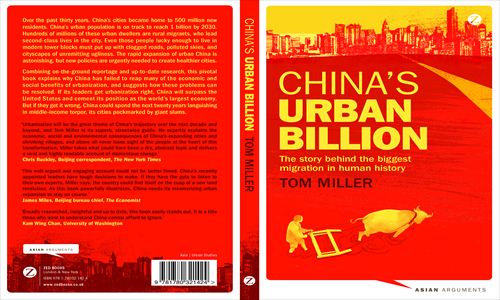City of outsiders


China's urbanization over the past three decades is a massive phenomenon of scale and speed. Back in 1980, there were less than 200 million people, a fifth of the population, residing in China's urban areas. However, by 2011, the figure soared to almost 700 million – half of the country's total population.
Fueled by the 250 million migrant workers moving to cities for the sake of a better life, the number has been projected to grow to an astonishing 1 billion by 2030, as described by Tom Miller in his first book, China's Urban Billion: The Story Behind the Biggest Migration in Human History, published in December.
The mass migration, which the author compares to the great immigration from Europe to the US a century ago, has impacted the country's economy, society and environment.
In the book, the Beijing-based British author, also managing editor at the China Economic Quarterly, expounds on the tough issues facing China, such as the hukou (household registration) system, the disappearance of arable land, possible property bubbles and the dysfunctional fiscal system which encourages local governments to sell land to make ends meet.
How the country handles the challenges brought along by the rapid urbanization will play a major role in shaping China's future, Miller argues.
Well-researched with nuanced analysis, each of the six chapters begins with a brief introduction of the general topic, followed by case studies of specific cities or urban residences, along with additional elaboration on background information. Through his observations, Millers also theorizes why China has so far failed to benefit from the economic and social gains of urbanization, and suggests how these problems could be resolved.
"Up to 250 million people in Chinese cities do not live genuinely urban lives, because migrant workers from the countryside are not entitled to urban social security and face institutionalized discrimination in the cities," writes Miller, who has been in China for more than a decade.
"As temporary residents with few legal rights, most migrants remain trapped in low-income jobs, save as much as they can, and buy few goods or services," he writes. "For this reason, China has failed to reap many of the economic benefits from its huge surge in migration."
Miller sees the hukou system, which deprives migrant workers of many social welfare rights, as one of the biggest obstacles preventing the rural population from integrating into city life.
In addition, the author, who has reported on the Chinese economy for a number of newspapers including the Financial Times, elaborates on the necessity of bold land reforms for healthier urbanization. Land is now collectively owned by local governments, and Miller argues that illegal land acquisition threatens farmers' rights, creating looming social instability and corruption in housing development during the urbanization process.
Pessimistic about China's growth, Miller disputes the speculation of a massive property bubble burst in the coming years, and states that, despite the fact that Chinese cities are identically ugly, congested and badly polluted, they are still attracting a steady influx of migration. This reaches as far as the otherwise remote Ordos in the Inner Mongolia Autonomous region.
In the end, the author makes the bold prediction that if the new Chinese leaders tackle the problems in the right way, China will surpass the US as the world's largest economy. If not, the urbanization could be a total disaster leaving the country fumbling its way ahead.
Never weighed down by figures and analysis, the book is a great read thanks to Miller's skilled writing and journalistic depictions of the many characters he meets during his travels and research in 85 Chinese cities. In one chapter, he vividly records the life of a young migrant couple who ignored the country's one-child policy and live in a cramped room of 15 square meters with their two boys. The young woman, who has been living in Beijing for more than 10 years, is still far from integrated.
"Chen's dyed brown, semi-frizzed thatch of hair marks her as an outsider: The shaggy dog look is not popular among fashionable locals," he writes.
Miller has been repeatedly explaining the importance of hukou reform, however, he fails to elaborate on other severe challenges that could dampen China's urbanization, including the growing demand for energy and natural resources. In response, the author told Metro Beijing it would be a totally different book if he had gone into environmental-related topics.
Beijingers can catch Miller speaking about his book at the Bookworm Literary Festival next Saturday, March 9, at the Sanlitun bookstore in Chaoyang district.